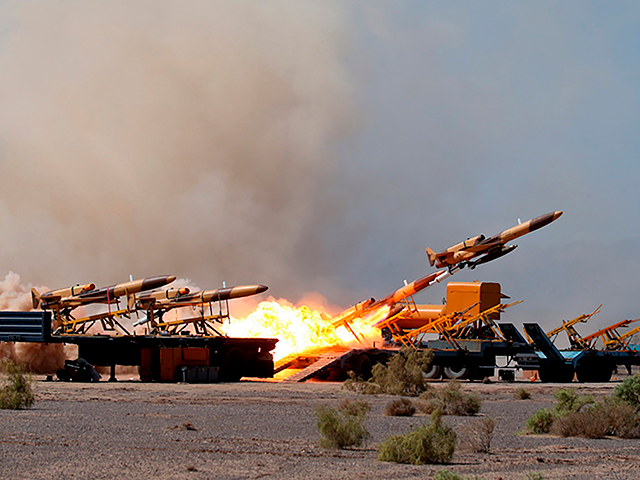The pro-Hezbollah Lebanese outlet Al Mayadeen reported on Thursday that a “suicide drone” of unknown origin successfully hit an American base in eastern Syria. Iranian state outlets amplified the report, but the Pentagon has not confirmed or denied the alleged incident at press time.
Al Mayadeen cited one of its reporters in Aleppo, who claimed the kamikaze drone “reached its goal after a strong explosion was heard in the area surrounding the U.S. base.” The base was allegedly in the Conoco gas field in Deir ez-Zor, close to the border with Iraq.
The attack, if confirmed, could mark a return to the heightened number of similar strikes on Americans in the region since October. The Pentagon has confirmed more than 165 attacks on American troops and assets in the Middle East in the past four months. A report citing anonymous sources by Reuters in late February, however, claimed that Iran had ordered its proxies in Iraq to stop targeting Americans out of fear that such strikes could elicit a devastating response, including potential strikes within Iran.
Iran’s state-run PressTV, which cited Al Mayadeen, emphasized that the “extent of the likely casualties or material damages resulting from the strike is yet to be known” and that no organization, individual, or other entity had claimed responsibility for the alleged attack — nor had any party allegedly involved acknowledged the incident. Mehr News, another Iranian state-linked propaganda outlet, cited a separate source for its report: an Arabic-language update on Sputnik, a Russian state propaganda outlet.
Sputnik reportedly used unnamed “local sources” to claim “massive explosions rocked Green Village, situated in the energy-rich Dayr al-Zawr province near the Iraq border.”
Iranian state media boasted on Wednesday that Iran had successfully produced a large number of “sophisticated homegrown kamikaze and combat unmanned aerial vehicles (UAVs)” that the Islamic Revolutionary Guard Corps (IRGC), a U.S.-designated terrorist organization and formal arm of the Iranian military, had taken possession of. Iran’s PressTV identified the drones as upgraded versions of the Shahed, a “kamikaze” drone that has made headlines for its reported presence on the battlefield in Ukraine, and the Ababil, an attack drone armed with missiles.
Both Mehr News and PressTV claimed, citing no evidence, that a likely culprit for the alleged attack on Thursday was the “Islamic Resistance in Iraq,” a vague term used for a variety of largely Iran-linked anti-American terrorist groups and militias in the country.
The terrorist brand “Islamic Resistance in Iraq” became prominent in the aftermath of the Hamas invasion and terrorist siege of Israel on October 7, in which 1,200 people were reportedly killed, and Hamas terrorists engaged in widespread infanticide, gang rape, and other atrocities. Hamas is a Sunni terrorist organization, but like many of the Shiite entities believed to be affiliated with the “Islamic Resistance in Iraq,” it receives funding and other support from Iran.
WHAT YOU NEED TO KNOW: Horror of the Hamas Terror Attack on Civilians at Kibbutz Be’eri in Israel
Joel B. Pollak / Breitbart NewsIranian proxies throughout the Middle East — including Iraqi militias, the Houthis of Yemen, and Lebanese Hezbollah — professed support for Hamas following the gruesome actions of October 7 and have dramatically escalated attacks on American and Israeli assets. The Houthis, who control the Yemeni capital of Sana’a, have arguably done the most damage with a maritime campaign against commercial shipping, targeting a growing number of cargo ships, forcing shipping companies to redirect out of the Red Sea region and towards the much longer and costlier route around the Cape of Good Hope in Africa.

A view of the oil tanker Marlin Luanda on fire after a Houthi attack on January 27, 2024, in the Gulf of Aden. (Indian Navy via AP)
Iranian proxies in Iraq and Syria have focused on attacking American targets. Their most successful attack occurred in early January, when President Joe Biden announced that three Americans died and many suffered injuries in an attack on American troops on the border between Syria and Jordan, on the other side of the country from Deir ez-Zor. The “Islamic Resistance in Iraq” took responsibility for that attack, and reports suggested that one particular Iran-backed Iraqi militia, Kata’ib Hezbollah, was the likeliest culprit.
Kata’ib Hezbollah issued threats shortly after against American assets but then abruptly published a statement on January 30 claiming “the suspension of military and security operations against the occupation forces,” meaning the United States. The group explained that it deemed the halt necessary “in order to prevent embarrassment of the Iraqi government.”
Reuters reported weeks later that the head of the IRGC Quds Force, Esmail Qaani, had visited Baghdad and ordered proxy forces, such as Kata’ib Hezbollah, to “lie low,” apparently out of fear of larger American retaliation.
“The Iranians learned their lesson from the liquidation of [Qasem] Soleimani and did not want this to be repeated,” one of the anonymous sources speaking to Reuters claimed. Soleimani held the leadership of the Quds Force before Qaani and was killed in a drone strike alongside Kata’ib Hezbollah founder Abu Mahdi al-Muhandis, which former President Donald Trump ordered in 2020.

COMMENTS
Please let us know if you're having issues with commenting.